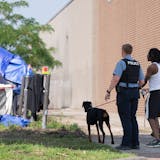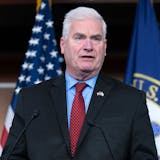An ambitious plan to coordinate Minnesota’s response to homelessness across state agencies — shaped by those who have directly experienced housing instability — will swing into action this spring.
The Crossroads to Justice Strategic Plan aims to reduce homelessness statewide by 15% by 2026 and to narrow large racial disparities among people experiencing homelessness. Another goal is to close racial disparities in mortality and improve the health of people facing homelessness.
“This plan, which will be our North Star for our state agencies, is comprehensive in covering approaches like increasing shelter capacity, as well as how to approach related needs such as ensuring that addiction treatment and recovery resources are widely accessible,” said Lt. Gov. Peggy Flanagan in a statement.
Some of the funds in the $2.6 billion housing stability package signed last year by Gov. Tim Walz will fuel the plan’s action steps, which include more funding for homeless shelters, rental assistance, affordable housing and support to help people find and keep housing.
Walz and Flanagan in 2022 delegated the Minnesota Interagency Council on Homelessness (MICH), a cabinet-level state advisory group leading state efforts on housing stability, to craft the plan. Over the next four years, about a dozen state and regional agencies will work to implement the plan in hopes of reducing barriers to benefits, housing and jobs, among other initiatives.
Agency-specific goals include better access to state workforce programs, a pilot program to improve food assistance to those who cycle in and out of homelessness, better housing and benefits for veterans, and more transitional housing for those leaving prison.
The Crossroads to Justice plan will shape priorities during the next legislative session, said MICH Executive Director Cathy ten Broeke, who has worked in government on efforts to end homelessness for more than 30 years.
The $2.6 billion state investment in housing “is a huge down payment on this work,” she said.

